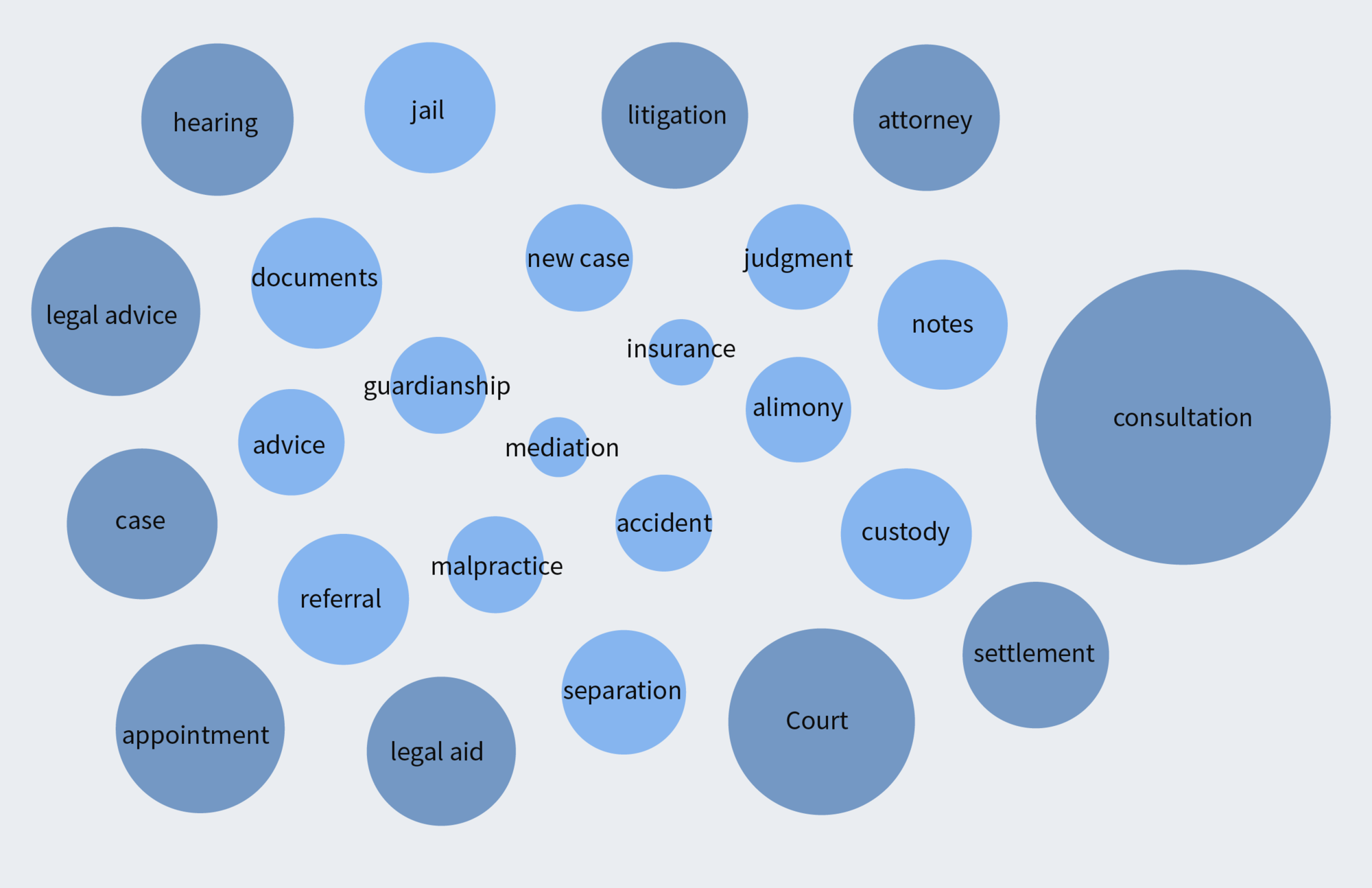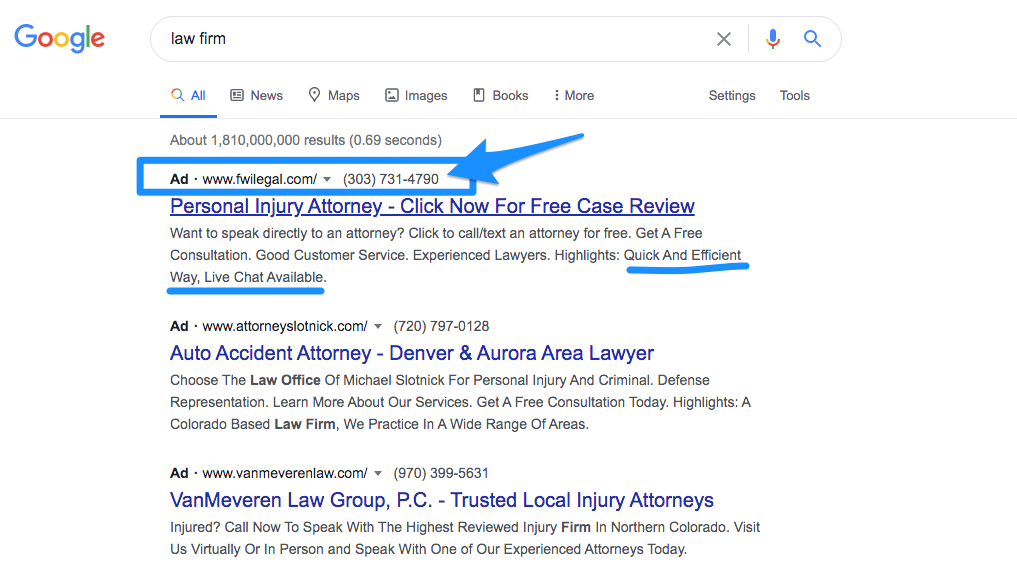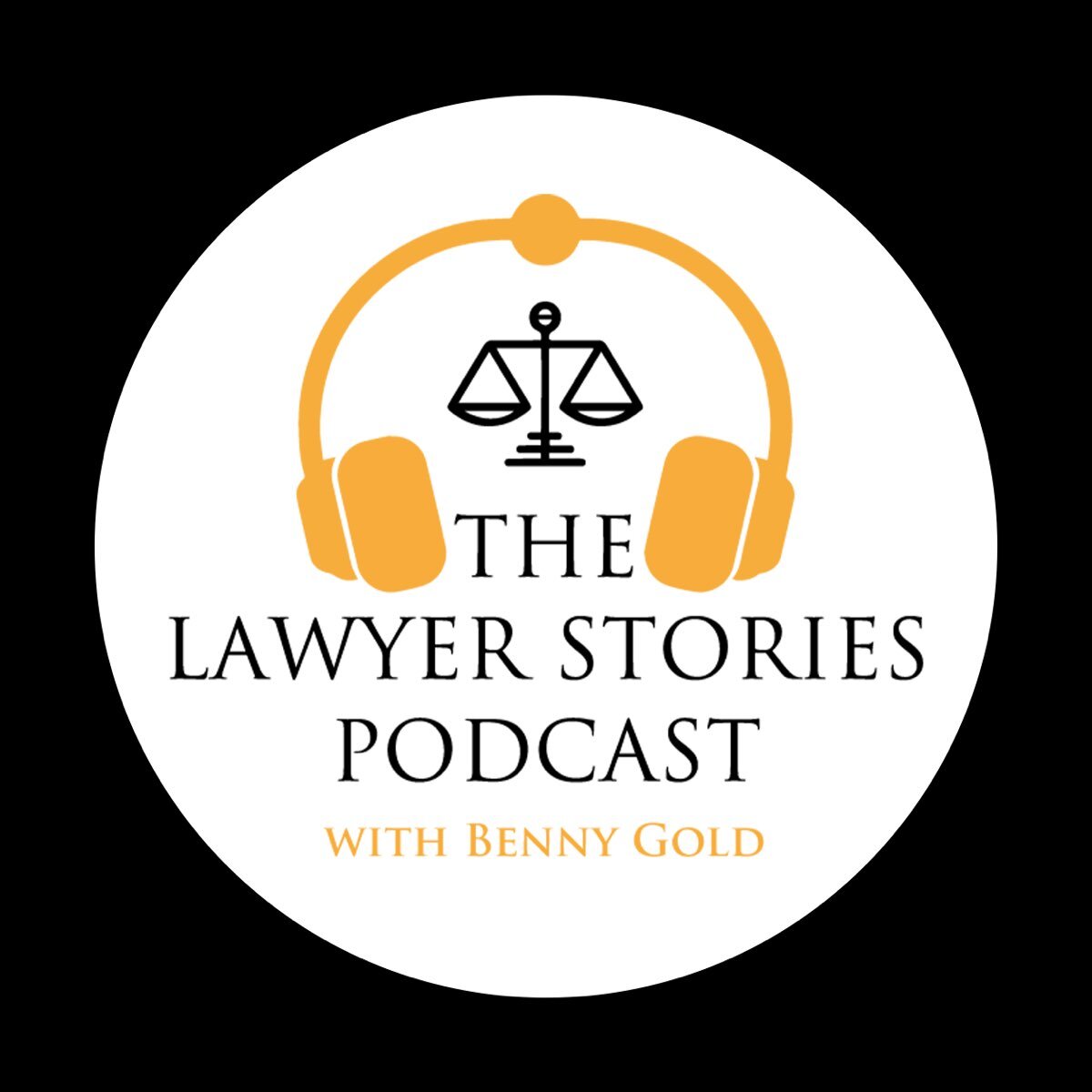Pay-per-click (PPC) advertising is a numbers game for law firms. You cast a wide net and hope to flood the top of your law firm advertising funnel with respondents.
Sounds simple, but you know the tricky part comes in when you boil down how qualified each of these leads is. Playing the same tired strategy over and over will certainly spend that PPC budget, but it cannot produce jaw-dropping results for long. (Especially in the law industry, where the cost per click on PPC ads consistently tops nearly any other industry.)
To make the most of your PPC budget, consider using the following tactics to stand out in the crowded law firm advertising space. These tips are mostly focused on Google Ads, along with some advice on other paid marketing channels. For those who need a refresher, check out this guide on how to make a PPC campaign and this post on what makes an effective ad.
1. Calls should be priority #1
A phone call from a lead is always worth more than a click on your website. Those who go through the effort to make contact and call about your services are close to paying for your services. The commitment of making a call far exceeds that of simply clicking a CTA.
To gain more high-value leads, set up call-only campaigns. These online ads direct users to call a phone number rather than visit a landing page or website first. They put you in touch with your leads quickly, and they’re well suited to mobile devices. Leads can call you right away by clicking the phone number on the ad.
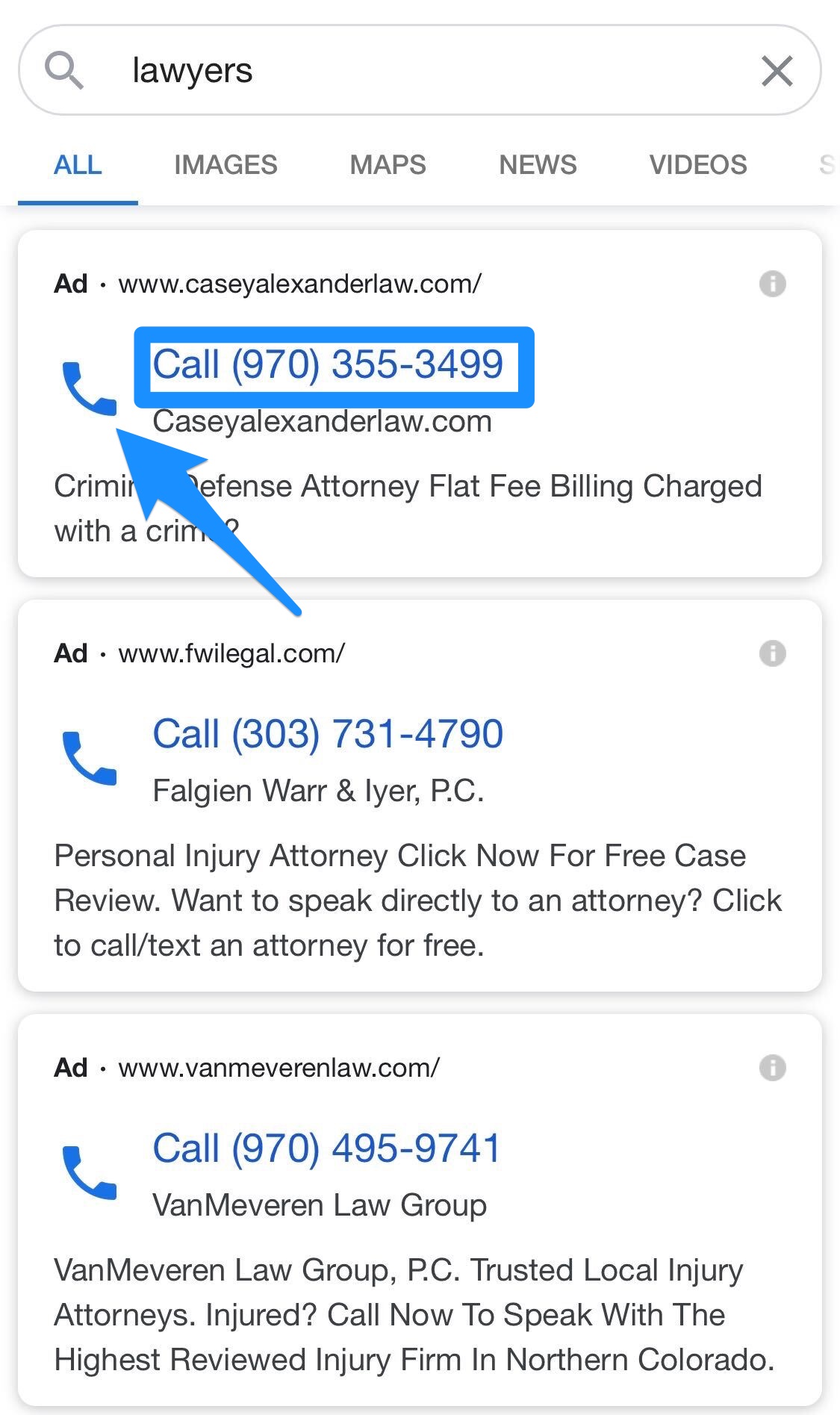
Be sure to put a 24/7 calling solution in place. Set up automated call responses or a chatbot window on your website to keep leads warm when you’re not available after hours.
That said, connect customers with live support reps as much as possible. A call center is a good approach as a first response, complete with scripts and a lawyer "on call" if a pressing question comes up.
Track which ads are driving the most calls. With a tool like CallRail’s Call Tracking, you can measure the most effective sources of calls. Use visitor-level tracking to understand which PPC campaigns get the most ROI.
You won’t be able to prioritize calls more highly overnight, but that focus will pay off as long as you hire someone to supervise the phone lines. That part can be done overnight.
2. Target small local areas
Law firms are always seeking clients, and targeting a large state area or even countrywide seems like an obvious way to expand your client base.
However, this approach for client acquisition will get growing firms like you into trouble. More likely than not, this strategy will yield leads that rack up lots of travel time for you and thereby will be cost-inefficient leads overall. To intelligently spend on clicks, limit PPC bids to smaller neighborhoods or city areas.
Update your location in Google Ads by clicking “Locations” (under “Settings”) and selecting your city or postal code. Or target more precisely using “Advanced Search,” and define a radius of the locality you serve, spanning ZIP codes.
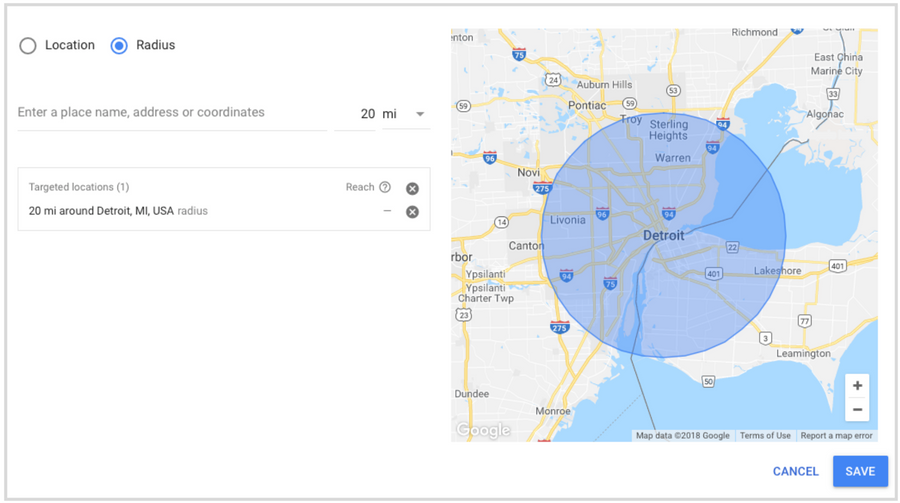
To collect even more value from your ad budget, allocate 100% of the budget on an ad to mobile (versus desktop) on certain local keywords. Since mobile now outpaces desktop for Google searches, paying closer attention to the mobile search experience will be a crucial growth driver for your firm. Read more about how to make mobile bid adjustments here.
3. Experiment with keyword match types.
Keyword match types are a way to control which Google searches will display your ad. Strategically choose match types based on what type of search traffic you want your ad to attract.
Broad match: Ad will display for search terms that include close variations of the keyword and related phrases that don’t include the keyword:
- Ex: “detroit family law” → “michigan family law”
- Ex. “detroit family law” → “detroit lawyers”
- Ex. “detroit family law” → “detroit michigan attorneys family law”
Broad match modifier: Ad will display for broad match search terms outlined above but will also include any additional terms noted, as well as close variations:
- Ex. “family law” +detroit +fast → “fast family law in detroit”
Exact match: Ad will display for exact matches or close variations of the exact term:
- Ex: “detroit personal injury lawyer” → “detroit personal injury lawyer”
- Ex. “detroit personal injury lawyer” → “detriot personal injure lawyer” (misspelling)
- Ex. “detroit personal injury lawyer” → “detroit personal injury lawyers” (singular / plural)
Phrase match: Ad will display for matches of the phrase or close variations on the phrase or synonyms with additional words before or after:
- Ex. “detroit family law” → “detroit family law lawyers” / “cheap detroit family law firms” / “family law near michigan”
Use a balanced approach when choosing your keyword match type. Sometimes you’ll need to target a very specific audience with an exact match. But to maximize your reach, you’ll also need broad match ads that cover a wider base.
4. Maintain a solid negative keyword list
While keyword match types seek to attract traffic to your ad, negative keywords specify which traffic should not see your ad. Keep and curate a spreadsheet of negative keywords to pair with your chosen target keyword matches from above in Google Ads to weed out low-quality leads.
Using this pair together is a powerful way to ensure that the traffic to your ads is well qualified for your services.
Common examples of negative keywords are “free,” “pro bono,” “cheap,” “low-cost,” “no commitment” or services you no longer provide. Maintaining a list of phrases you want to actively target (and not) will ensure you are maximizing spend and not wasting it on leads who you can't serve.
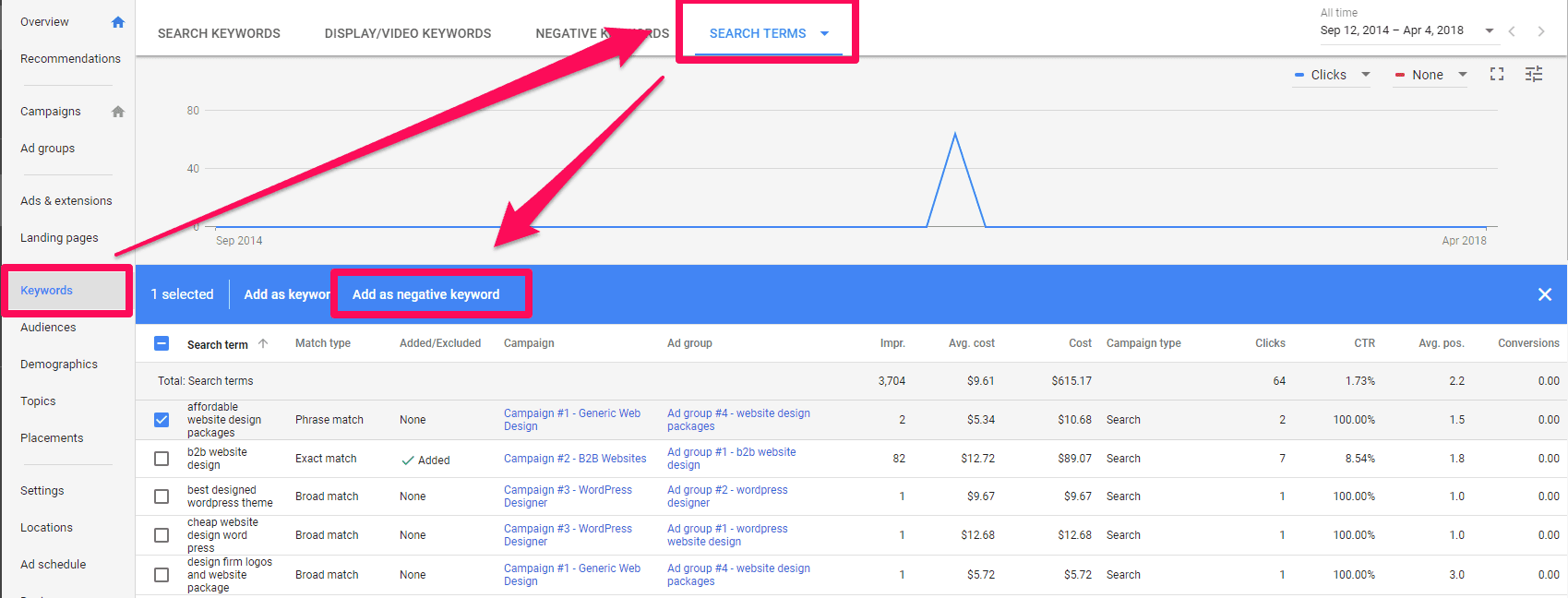
To use negative keywords with keyword match parameters, include a hyphen at the beginning (ex. “-free”) to exclude those terms or phrases.
Don’t neglect the “maintain” aspect of this negative keyword list, either. Regularly review reports of what keywords you’re receiving clicks for, but that have low conversion rates so you’re always adding to this list.
Identify which keywords are driving phone calls with visitor-level tracking with CallRail and which keywords arise that correlate to lower quality leads. These keywords might be good choices to add to the negative keyword list.
5. Level-up PPC copywriting
Your PPC copy might need some tweaking, especially if you’ve been in the law PPC game for a while. Implement a refreshed process to ensure that you’re making frequent revisions to ad copy before it goes stale.
Ramp up your ads in the copywriting department with these tips:
- In your ads, use language your audience uses. Collect data on your prospects and customers by “review mining.” Through this research, you can learn how their language about your services or firm may differ from your existing keywords. With this research in hand, you can craft ads that are more targeted to your audience, in their own words. Or let CallRail’s AI in Conversation Intelligence do the work. Our tool can tally and report common phrases from customer calls and compile them into word clouds.
- Focus on action-driven language. A CTA with directive language to “call” or “schedule” makes it very clear what the prospect should do, increasing click-through rate (CTR) and conversions.
- Be brand-forward, eye-catching, and differentiating. Showcase what makes your firm different in ads. Bring your brand forward in word choice and awards won, or directly compare yours with competitors' services.
6. Try out ad extensions
Ad extensions physically extend the real estate of a paid ad and provide the user with more options for how to easily follow up. There are dozens of ad extension types to try, depending on the most important information your leads need to know about your firm.
Check out two use-cases of ad extensions on the example SERP below:
- Call extensions (notated by arrow) display your phone number available at a glance.
- Callout extensions (notated by underline) are short, credibility building statements or CTAs.
Be careful about mixing in too many ad extensions on one ad competing for your prospect’s attention. As with CTAs, keep just one primary action front and center in your ads. Without one clear action for a prospect to take, they may become paralyzed by the number of options and not act at all.
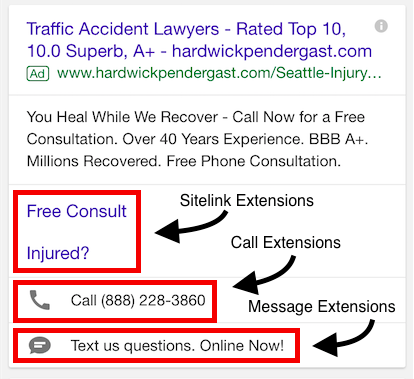
Consider these additional copy opportunities to convince your leads to convert. With more real estate in the search with ad extensions, you can increase the click-through rate on your individual ad by 10-15% on average.
7. Venture beyond Google Ads into paid social ads
Getting creative (like venturing into social ads) allows you to pioneer new territory for the legal field in advertising at a fraction of the cost and competition. (Don’t worry, we won’t recommend that you advertise on Snapchat.) For example, the average cost per action (CPA) on Facebook is $18.68 to Google Ads’ $48.96 across industries.
Two smart outlets for law firms to foray into are Facebook and LinkedIn:
- Facebook ads for lawyers: If you’re just getting started with Facebook ads, you’re in luck. Facebook is gaining clout as another “search engine.” Here, prospects connect, review and search for professionals to work within their local area. It’s also a unique way to humanize your firm and position yourself as an approachable neighborhood presence.
- LinkedIn ads for lawyers: LinkedIn is a major hub for reputable resources from fellow professionals. A solid LinkedIn law firm advertising strategy involves completing a company profile, creating content to answer leads’ legal FAQs, promoting content on LinkedIn Pulse and publishing ads.
8. Supplement cost-effective leads through Bing
To make the most of your PPC ad spend, you should consider advertising on Bing. Yes, Bing.
Bing supports 7% of search volumes in the United States. Not only that, but Bing ads are up to 70% cheaper than Google Ads. That’s some powerful support to advertise with Bing, and there’s less saturation by competition as compared with other search engines.
Plus, it’s easier than ever to import your Google Ads into the platform’s backend—read on here for how to get started advertising with Bing.
Capture more of your potential audience in a less competitive space, and stretch your PPC dollars further with Bing.
Power your law firm advertising with CallRail
Now that you’ve poured all this effort into your PPC strategy, spread the love to the end of the process: landing pages. How could they perform better to complement your PPC performance? To give conversion rates on landing pages a boost, consider adding video and other engaging elements. The best part? CallRail can help you measure every advertising touch point.
CallRail is your accountability partner, making sure you get the most out of your law firm advertising budget. With data-backed features like visitor-level tracking, automation rules, and call tracking, you can foster each lead and justify your PPC budget with confidence. Read more on how we work with lawyers to support and track their PPC campaigns.




